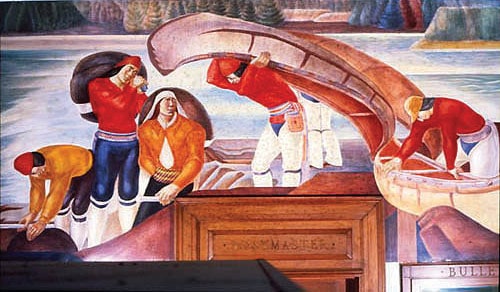Childhood Memories Evoke the Stirrings of Wilderness Experience
By Pat Kallemeyn, Wilderness News Contributor

One of my most vivid childhood memories is of the voyager art installed in my hometown’s post office in White Bear Lake, Minnesota; “Early Voyageurs at Portage,” a tempera by Nellie G. Best (1940), dominated the walls and ceiling. At an early age the painting stirred something in me, beckoning me. I remember considering these men with their lonesome yet resigned expressions. While my mother collected the mail I would gaze up at them picturing myself in their midst. The smell of canvas and heat in the WPA era public building enveloped my senses, pulling me into the painting. The idea of belonging to an age of exploration and discovery appealed to my young mind.
Now, taking a second look at their faces I also sense satisfaction and hopefulness. The artists’ depiction elicits an emotion similar to what I would expect the actual experience to produce. In some ways the artistic lens magnifies the essence of what is being conveyed. The feeling that my childhood communion with the voyageur painting produced comes to me still. The power of nature has become the essence of my spirituality. Wind singing through the top of giant white pine gives me pause and hints at something bigger while vast expanse of natural wilderness makes me keenly aware of my vulnerability.
Unlike the voyageurs our lives have become insulated from hunger, rain, disease and in many ways from the direct connection we once had with the land. Don’t get me wrong, I appreciate the fact that my kids don’t go hungry and that we have a roof over our heads. But because technology gives us so much it’s easy to ignore the war that is being waged between technology and spirituality. Technology gives us proof so we no longer need to rely on faith. Eliminating the feeling of vulnerability impairs our ability to connect spiritually. Without putting yourself at risk you’re not letting nature have any real power over you. Imagine viewing a lion at the zoo its massive paws flexing its hot breath coming in pants. Now take away the bars… the difference in the experience is palpable. Our connection with the environment lies in its grave as technology shovels on dirt.
Crawling out of our safe little techno bubbles will require some effort. Like a diet or getting in shape. Shedding the gadgets, and taking on some personal risk can produce a more satisfying wilderness experience. I’m not saying you should risk your personal safety. Start by risking your convenience. Leave your GPS at home and try it with a map and compass. Get lost for a little while, feel the anxiety build, then the relief and satisfaction as you realize you’re still on course. This was everyday stuff for the now extinct voyageur.
What I find fascinating is that the voyageur has vanished but the canoe has not. For all practical purposes the canoe should be a distant memory, a sepia tone image, slowly decomposing next to the threshing machine at the county fair. Our refusal to scrap the canoe suggests that it has become much more than transportation. It has evolved into a vehicle for the spirit helping us to connect with the environment, symbolic of a time when we were more vulnerable. The painting, too, stems from an era of vulnerability. Many post office murals, including this one, were commissioned through the Treasury Department’s Section of Painting and Sculpture in the 30’s and 40’s. While the great depression was devouring the hubris of the roaring 20’s artists were producing works that speak of a collective consciousness. The vulnerability of that era seeps into the artwork and is captured here alongside that of the voyagers.
Getting lost in art can be an adventure. A vehicle for your imagination, transporting you back in time alongside the voyagers or where ever you might want to go.
The mural is currently “missing.” It is thought that the entire wall with the mural was cut out in the late 1970s – early 1980’s when the old Post Office was remodeled. The location of this mural is unknown.
This article appeared in Wilderness News Fall 2008

